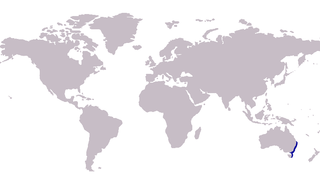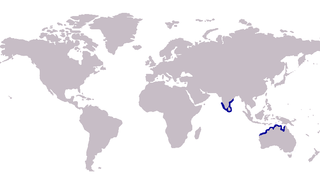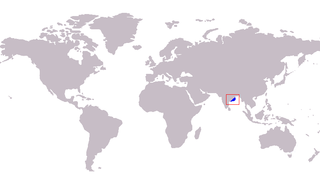
The Sillaginidae, commonly known as the smelt-whitings, whitings, sillaginids, sand borers and sand-smelts, are a family of benthic coastal marine fish historically classified in the order Perciformes, although the 5th edition of Fishes of the World places the family in the Spariformes. The smelt-whitings inhabit a wide region covering much of the Indo-Pacific, from the west coast of Africa east to Japan and south to Australia. The family comprises only five genera and 35 species, of which a number are dubious, with the last major revision of the family in 1992 unable to confirm the validity of a number of species. They are elongated, slightly compressed fish, often light brown to silver in colour, with a variety of markings and patterns on their upper bodies. The Sillaginidae are not related to a number of fishes commonly called 'whiting' in the Northern Hemisphere, including the fish originally called whiting, Merlangius merlangus.

The Gangetic whiting, also known as the Gangetic sillago or flathead sillago, is a species of inshore marine and estuarine fish of the smelt-whiting family, Sillaginidae. It is the most distinctive Asian member of the family due to its flattened head and trailing dorsal fins. Although first described in 1822, it was not placed in its own genus until 1861 when Theodore Gill erected Sillaginopsis, a genus which is still monotypic. Gangetic whiting are of minor commercial importance along the Southeast coast of the Asian continent where it inhabits protected areas.

Sillago is a genus of fish in the family Sillaginidae and the only non-monotypic genus in the family. Distinguishing the species can be difficult, with many similar in appearance and colour, forcing the use of swim bladder morphology as a definitive feature. All species are benthic in nature and generally coastal fish, living in shallow, protected waters although there are exceptions. Minor fisheries exist around various species of Sillago, making them of minor importance in most of their range. This genus has the widest distribution of any smelt-whiting genus, spanning much of the Indo-Pacific. The genus ranges from the east coast of Africa to Japan in the east and Southern Australia in the south, with most species concentrated around South East Asia, the Indonesian Archipelago and Australia. Many species have overlapping distribution, often making positive identification hard.

The oriental trumpeter whiting is a widely distributed species of benthic inshore fish in the smelt-whiting family. The species ranges from east Africa to Japan, inhabiting much if the southern Asian and Indonesian coastlines. Its morphology is very similar to other species within the genus Sillago, with a long, compressed body and silvery overall colour. It can be distinguished from its relatives by colour patterns and particularly swim bladder morphology, which helps define most species of Sillago. S aeolus is a benthic predator, consuming a variety of crustaceans and polychaetes. As with most members of the smelt whiting family, it is important to small coastal fisheries in various areas of its range.

The Asian whiting is a species inshore marine fish in the smelt whiting family, Sillaginidae, distributed along the Asian coastline from the Gulf of Thailand to Taiwan. The Asian whiting's appearance is very similar to other closely related species in the genus Sillago, with swim bladder morphology and ray counts of fins the most reliable identifying features. The species inhabits slightly deeper water than many of the sillaginid species its distribution overlaps, forming an important part of the whiting fishery in the countries within its range.

The slender whiting is a poorly known species of inshore marine fish of the smelt whiting family, Sillaginidae that has a distribution limited to the Persian Gulf only. The Slender whiting, like most sillaginids requires careful study to determine its identity, with ray and vertebrae counts as well as swim bladder morphology distinguishing features. This inshore species of fish is commonly taken by fishermen using beach seines and is sold fresh in local markets.

The club-foot whiting, also known as the club-foot sillago or thicken-spined sillago, the only member of the monospecific genus Sillaginopodys, is a coastal marine fish of the smelt whiting family Sillaginidae that inhabits a wide range including west Africa, India and the northern Indonesian Archipelago. The species is unique in the morphology of the pelvic spine and fin, making identification of the species easier than most of its relatives. The species is of minor commercial importance, taken by seine net and marketed fresh throughout its range.

The eastern school whiting, also known as the redspot whiting, Bass Strait whiting, Flinders' sillago, silver whiting or spotted whiting, is a species of benthic marine fish of the smelt-whiting family Sillaginidae. The eastern school whiting is endemic to Australia, distributed along the east coast from southern Queensland down to Tasmania and South Australia, where it inhabits sandy substrates from shallow tidal flats to depths of 180 m on the continental shelf. Eastern school whiting prey on various crustaceans and polychaete worms, with the diet varying seasonally and throughout the range of the species. Eastern school whiting reproduce in the deeper waters twice a year, releasing up to 110,000 eggs during a season.

Sillago indica, the Indian sillago, is a poorly known species of coastal marine fish of the smelt-whiting family Sillaginidae. The species was named in 1985, having previously being misidentified as another species of Sillago, S. parvisquamis. The Indian sillago inhabits the coasts of the Indian subcontinent and Oman. Like all sillaginids, it is benthic in nature, living in depths to 30 m where it is caught by fishermen alongside other species of Sillago.

The bay whiting is a species of coastal marine fish of the smelt-whiting family, Sillaginidae. The bay whiting's range extends throughout the west Indian Ocean, including northern Australia, Thailand, India and Taiwan, where it inhabits protected waters. It is benthic in nature, preying on shrimps, polychaetes and molluscs, however little else is known of its biology. Bay whiting are an important part of some inshore fisheries around Australia and Asia, where subsistence and commercial fishermen regularly take the species.

The Intermediate whiting, is a species of coastal marine fish of the smelt-whiting family Sillaginidae. The intermediate whiting ranges from the west coast of India to the Gulf of Thailand in the east, inhabiting silty substrates in shallow waters. First identified in 1977 from a specimen found in a fish market, the species has had little research performed on its biology, and is frequently misidentified as Sillago sihama or Sillago maculata intermediate whiting are commonly caught by fishermen throughout their range and are marketed fresh locally.

The mud whiting, or mud sillago, is a species of coastal marine fish in the smelt-whiting family Sillaginidae. The mud whiting was first described in 1985 and is currently known from the north west coast of Australia and the Indian coast.

The small-eyed whiting is a poorly known species of coastal marine fish of the smelt-whiting family Sillaginidae. The species is known from only two specimens; the holotype collected by Roland McKay in 1985 from a Taipei market, both specimens of which were taken from the waters of Taiwan. Apart from a relatively small eye size, the species is hard to distinguish from other common species of sillaginid taken in the area, and may be a minor part of local fisheries.

The northern whiting, also known as the silver whiting and sand smelt, is a marine fish, the most widespread and abundant member of the smelt-whiting family Sillaginidae. The northern whiting was the first species of sillaginid scientifically described and is therefore the type species of both the family Sillaginidae and the genus Sillago. The species is distributed in the Indo-Pacific region from South Africa in the west to Japan and Indonesia in the east. The northern whiting inhabits coastal areas to 60 m, but is most often found in shallow water around bays and estuaries, often entering freshwater. It is a carnivore, taking a variety of polychaetes and crustaceans. The species is of major economic importance throughout the Indo-Pacific. It is most frequently taken by seine nets and cast nets and marketed fresh.

The small-scale whiting, also known as the blue whiting, is a species of inshore marine fish of the smelt-whiting family Sillaginidae. The small-scale whiting is very similar in body shape and colour to other species in the genus Sillago, but is distinguished by having 12 or 13 spines in the first dorsal fin compared to 11 in all other species. The species is distributed through parts of the west Pacific Ocean including Japan, Taiwan, Korea and India, inhabiting the tidal flats of major estuaries. It is a benthic predator taking crustaceans, molluscs and annelids. Spawning in the species takes place from May to September, with peaks identified in June and July. The eggs and larvae have been extensively studied in order to distinguish them from the more abundant Sillago sihama. Minor fisheries exist for the small-scale whiting, although it is thought be endangered by habitat loss and pollutionIUCN.

The soringa whiting, also known simply as soringa or soringa sillago, is a poorly known species of coastal marine fish of the smelt-whiting family, Sillaginidae. The Soringa whiting is known exclusively from the east coast of India, inhabiting shallow inshore environments, particularly sandy substrates. S. soringa was first described in 1982 by Dutt and Sujatha, with the taxonomic status of the species was questioned by Roland McKay in his review of the Sillaginidae, with similar features to S. asiatica suggesting it is a senior synonym of the latter.

The estuarine whiting, also known as Vincent's whiting, is a species of benthic inshore marine fish of the smelt-whiting family, Sillaginidae. The estuarine whiting is very similar in appearance to the northern whiting, Sillago sihama, and as such was mistaken for the latter until 1980, when R.J. McKay identified the species based primarily on swimbladder morphology. The estuarine whiting is distributed along both the east and west coasts of India, primarily inhabiting the muddy substrates of estuaries. The species is locally important to fisheries in India, and is recognized as having aquaculture potential.

The yellowfin whiting, also known as the western sand whiting or fine-scaled whiting, is a species of inshore marine fish in the smelt-whiting family Sillaginidae. The species is endemic to the eastern Indian Ocean, ranging from Dampier, Western Australia to Gulf St Vincent in South Australia, with an apparent division in the populations of the two states. Yellowfin whiting inhabit relatively shallow waters for their entire life, often found on tidal flats and creeks, as well as large estuaries. It is one of the largest members of the smelt-whiting family, growing to 42 cm, and can be distinguished by a number of anatomical and colour related features. Yellowfin whiting are benthic carnivores, preying predominantly on polychaete worms, with minor amounts of copepods, amphipods and bivalves also commonly taken. The species shows a change in diet with age, and also dietary differences with other sillaginids presumably to minimize competition. Reproduction occurs at different times throughout its range, generally focused around summer, with up to 217,000 eggs produced per season. Yellowfin whiting reach sexual maturity at around 20 cm, with each individual spawning more than once. The species forms the basis of major fisheries in both Shark Bay, Western Australia and the two Gulfs of South Australia, with around 260 tonnes of fish taken each year. They are also a popular target for shore based anglers, with a reputation as a very good table fish.
Sillago shaoi is a species of marine ray-finned fish in the smelt-whiting family Sillaginidae. It is found in the western Pacific Ocean, in the Taiwan Strait between Taiwan and China.

Sillago suezensis is a species of marine ray-finned fish in the smelt-whiting family Sillaginidae. It is found in the western Indian Ocean and the northern Red Sea including the Gulf of Suez. Following its first record in the Mediterranean Sea, off Lebanon in 1977, it experienced a population explosion in Levantine waters where it is now very common and reaches to the Aegean Sea.

















